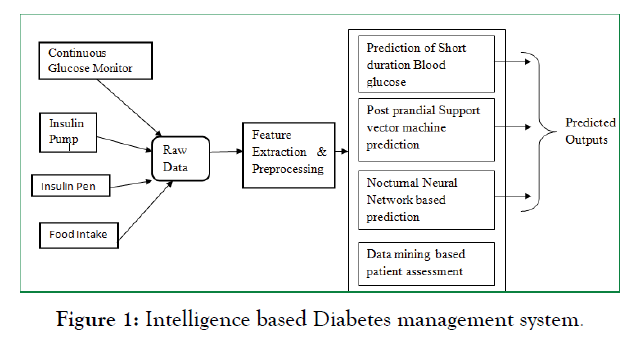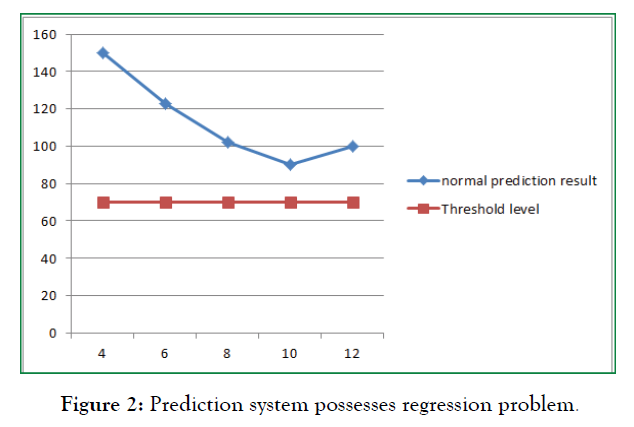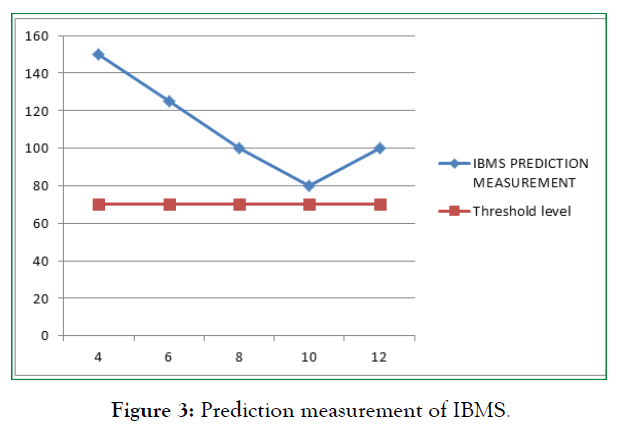Research Article - (2021) Volume 12, Issue 9
The use of continuous glucose sensors are currently trending in type 1 diabetes patients which provides enormous forthcoming adverse effects like hyperglycemia and hypoglycemia. The development of diabetes management system automatically collect sensor information and make correct recommendations to patients. The incorporation of Artificial Intelligence sensors supports glucose prediction in diabetes patients with fine tuning of bolus calculation and parameters.
Artificial intelligence; Decision support system; Prediction; Optimization; Diabetes; Continuous glucose monitoring sensor
The destruction of beta cells in pancreas responsible for insulin production causes a metabolic disorder in most of Type 1 diabetes (T1D). Since the body tissues absorb insulin persistently it leads to elevated blood glucose concentrations. The treatment of T1D includes regular exercise, exogenous administration of insulin, diet [1-3]. The under dosing of insulin causes a higher risk of hyperglycemia with a blood glucose concentration of 180 mg/ dl. Hyperglycemia causes retinopathy, cardiac related issues, lack of kidney and brain function too. Overdosing of insulin causes reduction in blood glucose below 70 mg/dl leads to coma stage and death. Basal dose of insulin is administered in patients while fasting and bolus insulin is given before each meal to avoid elevated glucose levels. After meal a correction bolus dose is also given additionally to correct blood glucose abnormalities. This is the standard method of insulin administration [4-6].
Existing Methods
Bolus Calculator is software (Schmidt, et al.) to calculate bolus dose of insulin in diabetic patients. Basal Insulin dose are administered satisfying patients insulin requirements. The patient general characteristics are given as the initial values as age and body weight. Daily activities like stress, bad health also affects the insulin sensitivity in patients [7,8]. Hypotreatment is done whenever hypoglycemia is detected providing fast acting carbohydrates at about15-20g. As a standard means continuous glucose monitoring is done by using capillary blood finger prick. By the American Diabetes Association critical risk areas such as driving will promote normoglycemia to hypoglycemia conditions. The management of type 1 diabetic therapy leads to manage 100000 and 500000 actions over patient’s life time. This burden seems to advent devices for glucose monitor and insulin delivery. Continuous glucose sensors give monitoring of sensors for consecutive days and week.
Intelligence Based Diabetes Management System (IBDM)
Short PH is focused on the glucose prediction forecasting on the further glucose concentration in the regression approach. To effectively handle the prediction of certain values larger PH values are desirable. If 3 hours after meal a hypoglycemic condition exists then the patient faces a overestimated insulin bolus. If a patient uses IBMS prediction method an alert for prediction will be generated before 30-15 minutes of the event so that the patient can able to consume additional carbohydrates. The best way to avoid the risk in the hypoglycemia is to reduce the bolus level in the meal of patients with extra carbs [9,10]. The prediction of glucose over PH value long is a highly challenging task. The binary value 1 is used for the event and 0 for not an event.
Based on the approach Cappon et.al [7] suggested a boosted tree based Gradient approach to adjust the bolus meal in the predicted class. The features including glucose concentrations, meal intakes and the administration of insulin can be denoted as an event of hypo/hyperglycemic conditions for the last 3 hours is denoted for the insulin intake or meal uptake.

Figure 1: Intelligence based Diabetes management system.

Figure 2: Prediction system possesses regression problem.

Figure 3: Prediction measurement of IBMS.
Main Features of IBMS Module
Prediction for short duration blood glucose
This prediction approach is based on the evolutionary algorithm considering all the continuous glucose data, carbohydrates and the features of input with a rate of appearance in the last 2 hours of time [11,12].
Post prandial support vector machine prediction
The prediction of support vector classifier is taken for every 4 hour after the meal. Nine complete features are detected to find the prediction. Five of the features is extracted from the continuous glucose monitor data with a basal insulin measurement taken with 2 hours and programming done for the 4 hours next with administration of insulin for current meal and after carbohydrate.
Nocturnal neural network based prediction
The nocturnal neural network based prediction is done at the meal time with the occurrence of the meal after every 6 hours before going to bed. The main features of this prediction are the continuous measurement of glucose during sleep time, blood glucose measurement and control in the last 6 hours of time, convergence region for glucose for the previous 30 minutes of time, carbohydrate appearance at the time of sleep announcement.
Data mining based patient assessment
The unsupervised clustering on glucose with data mining algorithm is due to data mining based patient assessment. This module identifies blood glucose control for single patient can be customized by training model.
Most of the prediction system possesses regression problem. The prediction horizon should be maintained below 60 minutes. The interstitial glucose value is predicted by the result of predictive alerts. If the prediction level exceeds the threshold level then an alarm is set. But the prediction measurement of IBMS is accurate with a correct hypoglycemic alert on 80 mg/dl.
To manage and maintain interoperable sensors there is a need to have large databases with all levels of glucose interstitial measurements. The continuous glucose measurement data can be provided from the medical devices using sensors, tracers and wearable health records. The data collected by the people can be automatically detected for exercise sessions with a high note of hypoglycemic conditions.
By the current research trend with artificial intelligence technique it is possible to reduce patient burden with IBMS management system and hence control glucose level.
Citation: Anchana PB, Auxillia J (2021) Intelligence based Diabetes Management System. J Diabetes Metab. 12:897.
Received: 03-Sep-2021 Published: 23-Sep-2021, DOI: 10.35248/2155-6156.21.12.897
Copyright: © 2021 Anchana PB, et al. This is an open access article distributed under the terms of the Creative Commons Attribution License, which permits unrestricted use, distribution, and reproduction in any medium, provided the original work is properly cited.